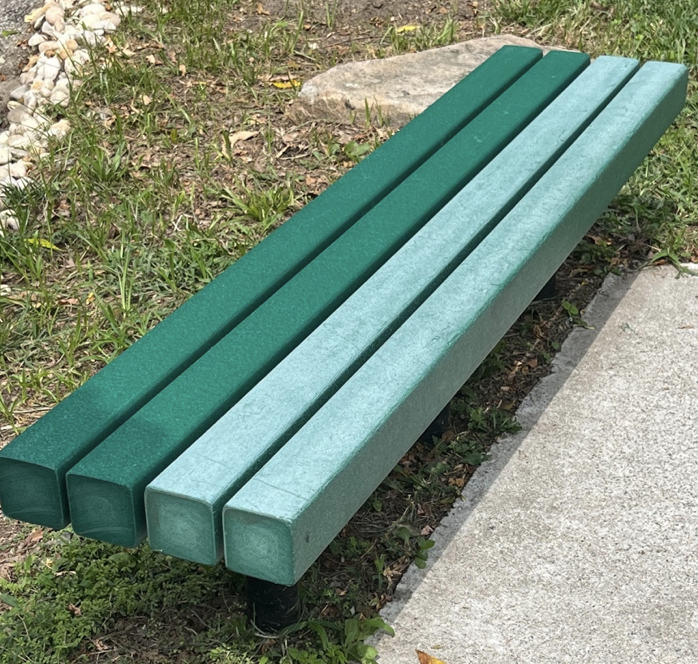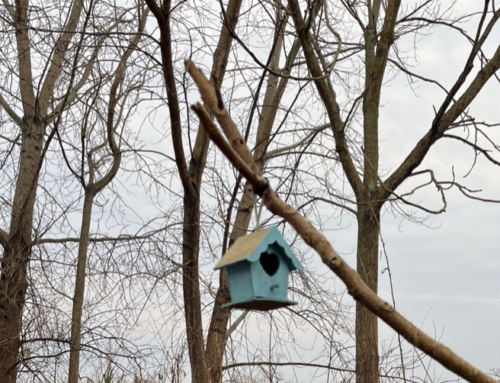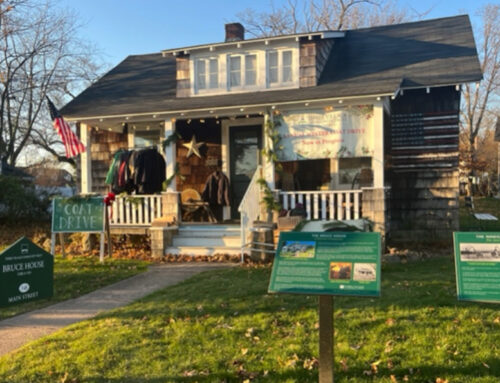The Trail Mix
A newsletter for and about the Setauket to Port Jefferson Station Greenway
The Trail Mix is the monthly newsletter of The Friends of the Greenway. We established this bulletin to keep the Friends and users of the Greenway current on some of the “goings- on” regarding our Trail and to dispense a mix of bits and bytes of flavorful information. Hopefully, The Trail Mix will help to enlighten, inform, and entertain our readers. The Friends of the our parent organization – The Three Village Community Trust.

Electric Bikes – Friend or Foe – Part I
In a recent issue of Trail Use, Scott Stark wrote an interesting, and comprehensive, article titled Exploring America’s E-Bike Revolution. Understanding that we will see more and more e-bikes on the Greenway in the very near future, we thought it would be valuable to share some of Scott Stark’s observations in this issue of The Trail Mix. This is the first part of a two part series based largely on Stark’s Exploring America’s E-Bike Revolution. ( Certainly, this series will be of interest to users of the West Meadow Beach peninsula – e-bikes are coming there, too!)
We thank Scott Stark and the Rails to Trails Conservancy for permission to reprint parts of Exploring America’s E-Bike Revolution.
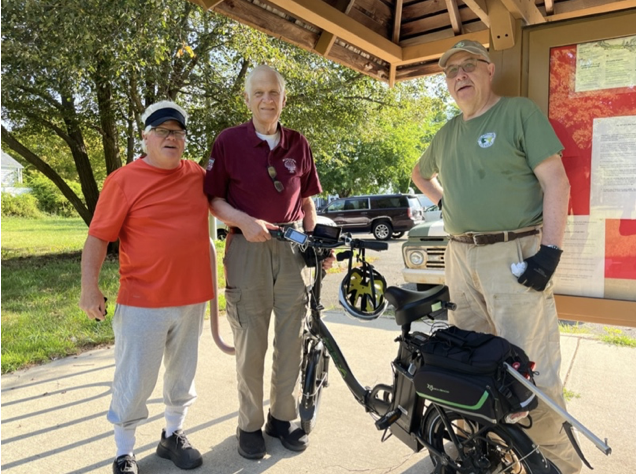
Mike Hall with his e-bike, Steve Englebright and Charlie McAteer
First of all – some background about e-bikes:
As a board member for Rails to Trails Conservancy, and an owner of Wheel and Sprocke—a chain of 12 bike shops in Wisconsin and Illinois— Noel Kegel, is very familiar with e-bikes. Kegel says he has seen explosive growth in the number of e-bikes sold to older customers.
And while an older demographic originally led early e-bike adoption, with somewhere around 80% of his e-bike customers being retirees, Kegel said that it’s “sort of changing—now it’s younger families, maybe zero-car families that are using cargo e-bikes as a car replacement, or commuters trying to get from A to B in the most efficient way they can.” With urban congestion being the norm most hours of the day in many cities—including Milwaukee and Chicago, where Kegel spends much of his time—he observed that “e-bike trips can easily be faster than driving or taking the bus.”
At their heart, electric bikes—generally shortened to e-bikes or e-assist bikes—are otherwise traditional bikes and trikes that utilize a small battery-powered motor to augment a cyclist’s pedaling efforts. There is also a class of e-bike that can be activated solely by a throttle. Commonly sold e-bike motors generally output between 250 and 750 watts (or between a third and a full horsepower).
The electric assist is typically used by riders to keep up their pace over distances or up inclines. Despite the performance boost, Kegel said that riding an e-bike “is a very intuitive experience. It’s just like riding a [traditional] bike, but it makes you feel stronger than you actually are—you feel like Superman.”
It might be that superhero ability that creates concerns for some users of multiuse trails or gives rise to the idea that an e-bike differs from a motorcycle only in name.
As e-bikes have risen in popularity—extending access to trails and bicycling for many—their increased presence, during a time when trail policies and recommendations are in their infancy or vary at the local, state and national levels, has also led to questions around their use and, at times, negative perceptions.
A cyclist and e-bike activist in Palo Alto, California, Paul Trainer has been riding e-bikes since long before they were commercially available and takes issue with the motorcycle comparison. “I built my first e-bike when I was in high school; this was in like 1969,” he said. “They’ve been a part of my life forever.” Trainer’s first home-built e-bike was powered by lead-acid batteries carried in modified saddlebags—the same bulky, heavy batteries that have powered the starter motor of automobiles for decades.
While today’s refined e-bikes have much better batteries and more powerful motors, “they are still essentially bicycles,” argued Trainer. “They’re still made out of bicycle parts.” Trainer is adamant that comparing a motorcycle even to those types of e-bikes that move with just the push of the throttle misses the mark. E-bikes are very nearly silent and emit no exhaust; trying to compare a single-horsepower electric bike to a motorcycle that outputs 100-plus horsepower, Trainer said, is a false equivalency.
And it’s not just a philosophical distinction, said Dr. Ash Lovell, the electric policy and campaign director of PeopleforBikes, the bicycle industry’s trade association. Her organization developed the three-class system of categorizing e-bikes [see below] that has so far been codified into law by 40 states. “Anything that goes faster than 20 miles an hour with throttle power is just not an electric bike under the definition,” she said. But legal definitions aside, Lovell noted that “technology always wants to get ahead of regulation” and pointed to increasing numbers of direct-to-consumer products that are pushing the limits of the definition of an e-bike in terms of their size and speed—going outside the bounds of the classifications that are becoming a universal guide for understanding the technology.
…….
E-Bike Classes
- Class 1: You gotta pedal: E-bikes are pedal-assist models with motors that work only while the rider is pedaling. They have a top speed of 20 mph, at which point the motor automatically disengages. While riders can go faster, any speeds above 20 mph are courtesy solely of the rider’s muscle power.
- Class 2: Vrrroom: E-bikes have a throttle, allowing the motor to power the bike even without the rider pedaling. The motor stops providing assistance at speeds in excess of 20 mph.
- Class 3: Super-bikes: E-bikes are the most powerful; again pedal-assisted, these bikes can reach 28 mph before the motor stops providing power.
…….
Typically, when e-bikes are allowed on multiuse trails, they have been Class 1 and 2, and subject to the same rules and regulations that govern other cyclists.
Regardless of what classification tier they fall into, e-bikes are the fastest-growing segment in the bike industry and, for several years now, have even outpaced electric vehicles in terms of units sold, said Lovell.
Lovell noted that the speedy adoption of e-bikes over the past decade can be attributed in large measure simply to the joy they bring to riding, but also because they “reduce a lot of barriers for people to get on their bike at all. Maybe you’re … not as physically fit as you once were, but you still want to get out and ride,” she said.
Upon their retirement, Stan and Roz Boyer started working part-time at Kyle’s Bikes in Waukee, Iowa, where they say that they, too, have seen a stratospheric interest in e-bikes. “I can’t tell you as far as a percentage of sales,” said Stan, “but just from riding around our [RTC Hall of Famer Raccoon River Valley Trail], I know there are probably two or three times as many e-bikes as there were just four or five years ago.”
“We have people coming into the shop who say, ‘If it wasn’t for [e-bikes], I wouldn’t be getting outside and exercising at all,’” he added.
Surrounded by customers embracing e-bikes, Roz saw their benefits and purchased one for herself, but Stan has been a holdout. Approaching 68 years old, Stan is paraplegic and rides a hand-cycle. “I just don’t know how much longer my shoulders can do what I want to do,” he conceded, but despite being perhaps the poster child for e-bikers, Stan said he had personal reservations about letting a motor do any part of the biking work. “I guess I’m a purist at heart.”
While both Boyers say they have seen firsthand the benefits of e-bikes—from an 87-year-old customer extending his riding years, to adaptive trike riders using the boost to get where they couldn’t otherwise go—they also expressed varied reservations about throttle-controlled e-bikes.
Stan used to feel that only bikes requiring pedaling input should be allowed; however, his wife’s recent knee replacement had him rethinking that stance. “I am still concerned people will abuse the throttle,” he said, but now believes “there is a place for throttle-assist bikes.”
Roz said she is concerned by e-bike riders who go faster than trail etiquette demands; not only do they put themselves and others at greater risk in the event of a collision, she said, but their actions could increase the appetite of trail managers or legislators to impose artificially low speed limits on trails. “That would put a lot of serious riders,” whether on e-bikes or not, “out onto the roads competing with traffic,” she said. To be continued!
Congratulations and Thank You Eagle Scout Joseph Sciotto
A Force Of Nature!
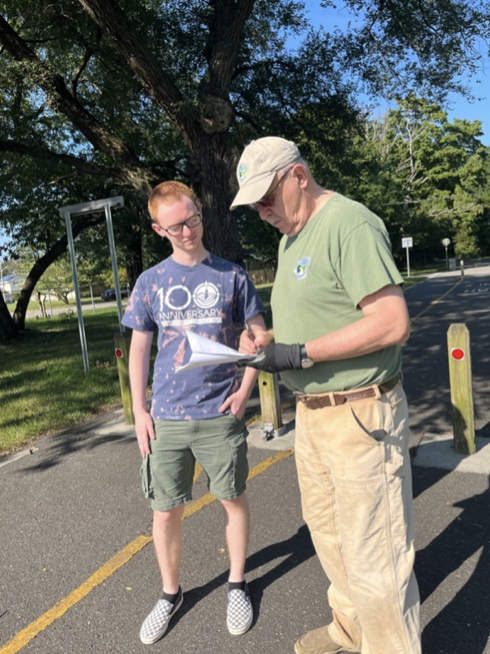
Charlie McAteer signs paperwork verifying Joe Sciotto’s Eagle Scout Project
We thank Joe Sciotto’s Eagle Scout project on the Greenway! Joe was able to restore one of our damaged benches, and then installed a wonderful pollinator garden at the Middle-Trailhead near Gnarled Hollow Road in Setauket. Here are some photos of his amazing work:

Our August Cleanup
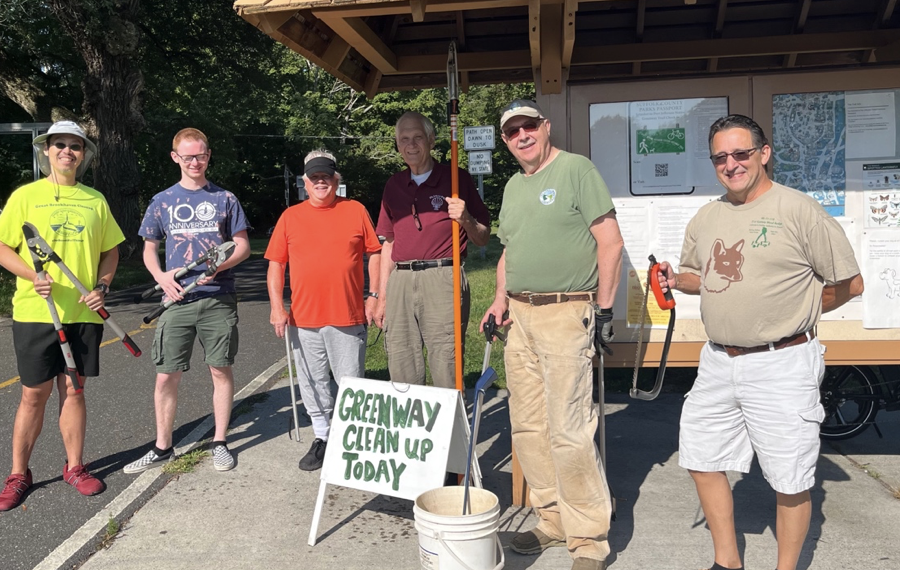
On Saturday, August 12, we continued our cleanup efforts on the trail. The Port Jefferson Trailhead section has been our focus over the past several months, and we continued to transform the trailhead area into a beautiful meadow. No small feat considering that just three years ago the area had a mashup of broken tree limbs, debris, and litter. Thank you volunteers!!
Who’s That Steward?
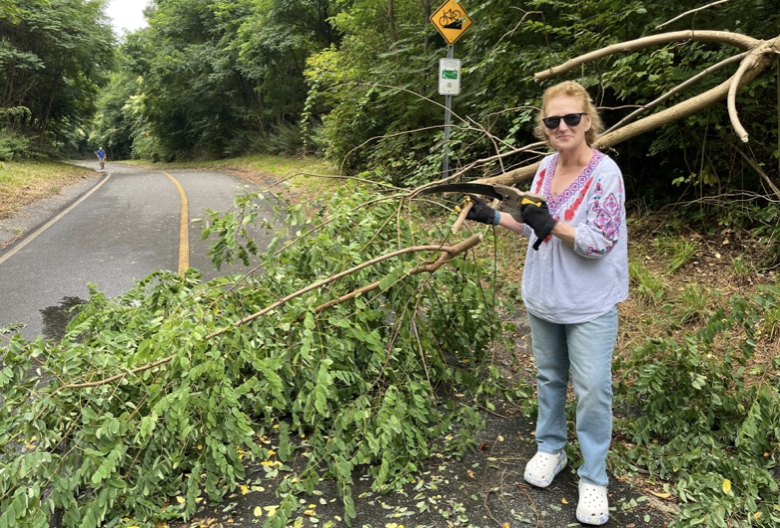
Sometimes trees fall and block portions of the trail! We thank those stewards who respond to problems lickety-split. Here, Gretchen Oldrin Mones cuts up the last parts of a fallen tree on the Greenway. And with a small tree saw! Wowzer!
Our Fall Clean Up Schedule
Wow! Our regular Clean up schedule is quickly coming to an end! September 9th is our last regularly scheduled clean up for the year!
- Saturday, September 9th at 9am, Starting location: The Port Jefferson Station Trailhead
Need more information?
Want to become a Trail Steward? Wish to Donate to the Greenway? Want to be on the Friends of the Greenway’s email list?
Email Herb or Charlie:
HJMones@gmail.com cfmcateer@gmail.com

Our Special Friends
Keep in mind, these special friends of the Greenway who support our efforts throughout the year! Please consider giving them your business, and mention you saw them in The Trail Mix.
Bagel Express at 15-5 Bennetts Road in Setauket. Owned and operated by David Prestia, Bagel Express generously donates the catering of our Trail Steward breakfasts. Delicious bagels, hot, steaming coffee – sooo good! For the third year in a row, The Trail Mix has voted Bagel Express #1 for breakfast and lunch, and all of your catering needs. Call 631-675-2770 or check website at Bagel Express – New York | View our menu, reviews & Order food online (bagelexpressli.com)
A Big Friend of the Trust is Swan Cove Landscaping. Swan Cove does a whole line of services – lawn maintenance, pruning, stone walls, firewood. Dave Fortuna, owner/operator, donates many, many of his services to the Trust. The result – our properties always look great! Thank you, Dave! Call 631-689-8089.
Emerald Magic Lawn Care’s horticultural consultant, Craig den Hartog has been providing flower bulbs for the Greenway over many years at “no cost.” We planted a big bulk of these bulbs at the kiosk on Gnarled Hollow Road, Setauket. Craig generosity is part of his beautification effort known as Old Town Blooms. And, Craig was a driving force behind the recent Great Daffodil Dash benefiting the Port Jefferson Station-Terryville community! Why not support Emerald Magic who supports us! Call 631-286-4600, 631-804-9205.
For your yard’s beautification look to Setauket Landscape and Design. Steve Antos can help you plan and design the unique surroundings to make your property the envy of your neighborhood. His company has helped us with many large and small projects on the Trust’s historic properties. Call 631-882-7190.
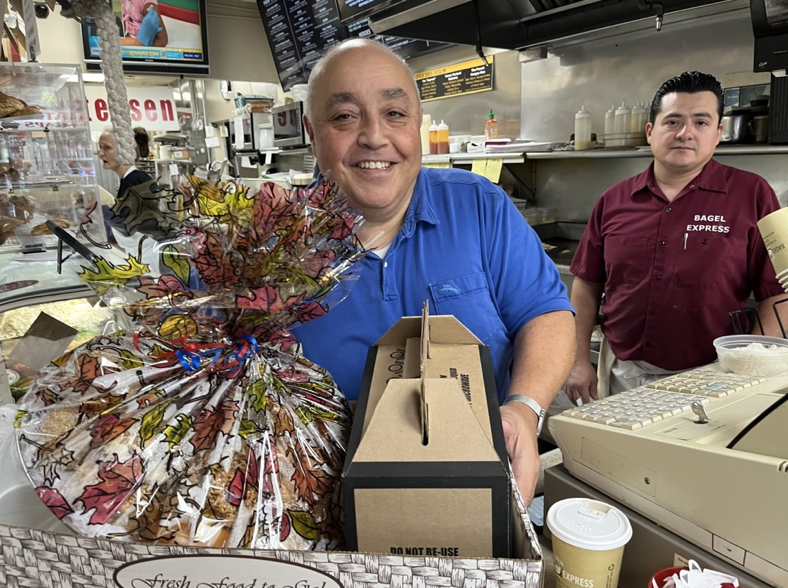
Shown above is Dave Prestia, owner/operator, of Bagel Express
And lots of thanks to Bove Industries and Skyline Industries for their generous support of the Trust’s projects – they have been instrumental in our grounds restorations at the Smith/deZafra House! Bove Industries and Skyline Industries are leaders in producing materials for roads and construction products.
Randall Brothers Tree Service is always a big help and big hearted in helping the Trust! Call 631-862-9291. Marty is the Man!
Jos. M. Troffa Materials Corporation at 70 Comsewogue Road in Setauket is a very special friend. The company has every conceivable item to beautify your yard. Mulch – they got it. Grass seed – yes! Soil, gravel, shovel, – everything. Forget the big box stores – You gotta go to Troffa!
Editor in Chief – Herb Mones

